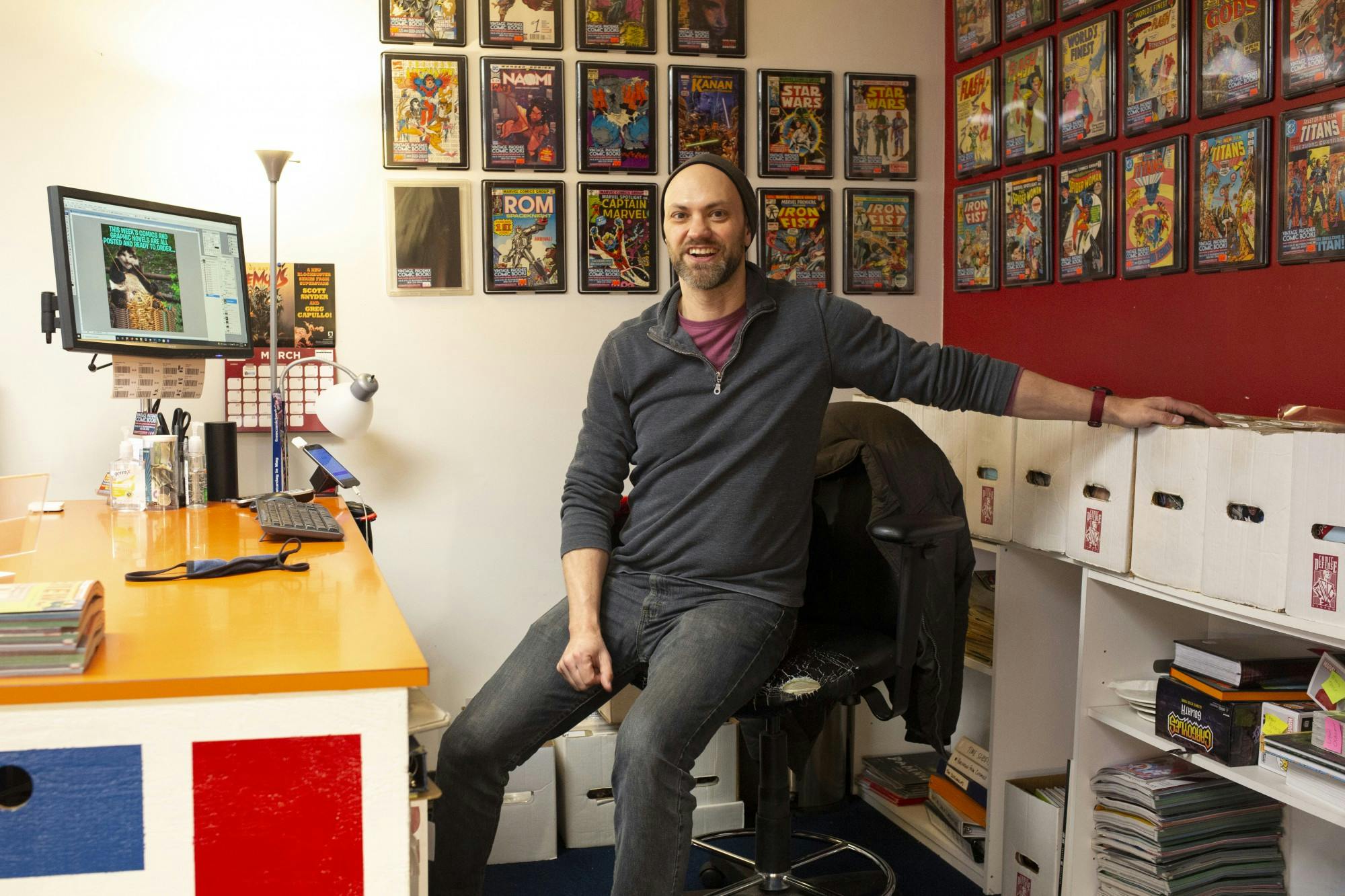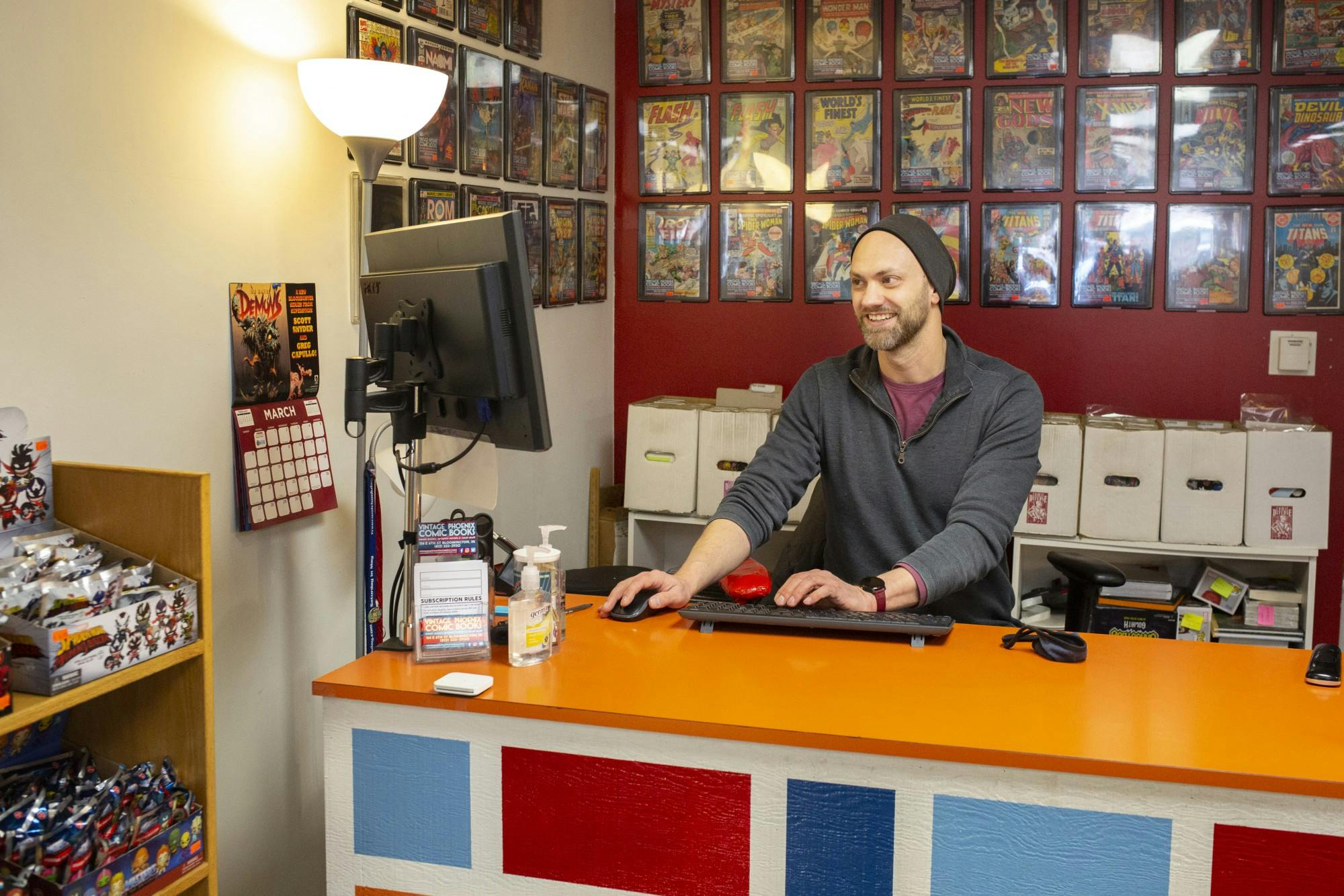Matt Traughber sits at his desk in the back of Vintage Phoenix Comic Books in downtown Bloomington. As he looks toward the store’s front window, he enters an unending staring contest with thousands of eyes.
Some squint defiantly back at him from behind masks, some crackle with fiery heat vision, but none of them blink.
The colorful characters glaring at Traughber from the sale racks have been his livelihood since he purchased Vintage Phoenix about five years ago. As co-owner and manager, Traughber’s job is figuring out how many of each character’s stories he needs to put on his shelves every week.
Order too few, you lose customers, you go out of business. Order too many, you spend more than you can make — you go out of business.
Traughber said there’s no playbook on how to run a comic book store, but fortunately he’s had more than 20 years working at Vintage Phoenix to learn how. It also doesn’t hurt that, by and large, people in the United States really like superheroes.
“There is something primal about superheroes, at least with Americans,” he said.


In the modern western entertainment industry, few things turn a buck like a superhero.
North American comic book sales hit $1.28 billion in 2020, Publishers Weekly reported, marking a $400 million increase since 2012. Then there are superhero movies, which generated nearly $10 billion in domestic box office revenue in the last five years and accounted for over 35% of all domestic box office revenue in 2021, according to IMDb.
Superheroes haven’t merely broken into the mainstream. They have become the mainstream.
To a certain extent, the money and popularity don’t surprise Traughber — he said tall tales of heroic individuals with exceptional abilities are nothing new. What surprises him is the fact that some of those billion-dollar movies prominently feature protagonists such as an alien raccoon, a talking tree or a man whose signature ability is communicating with fish.
He said although superheroes have always had their fans, they long carried a stigma of low-brow entertainment for children.
“Not only was it embarrassing for some people to read comic books, historically, people who made them were sort of embarrassed.”
—Matt Traughber, Co-owner and Manager at Vintage Phoenix Comic Books
Even the late Stan Lee — longtime Marvel editor and co-creator of icons such as Spider-Man, Iron Man and the Hulk — used to conceal his profession from others out of self-consciousness.
“I was embarrassed to talk to people about what I did then,” Lee said in a 2014 interview with the Chicago Tribune. “I would meet someone at a party and they would ask what I did and I would say, ‘I'm a writer,’ then start to walk away.”
But superheroes still captured enough hearts and minds to populate newsstands, even if their creators were often ashamed of them.
“The kids who read those books, they don't know that,” Traughber said of the stigma. “They love them. Fifteen, 20 years later when they're writing them themselves, the ones who grew up to be pros, there's none of that shame.”
Advertisement
Stuart Sayger, 49, was one of those kids and now, he is one of those professionals.
Sayger said he loved comics as a kid because he didn’t feel like they talked down to him the way many made-for-children products did. In addition to his fascination with comics, he also grew up with a love of drawing.
Since graduating from IU with a journalism degree in the late 1990s, Sayger has parlayed his childhood pastimes into a career as an illustrator for publishers including DC and Image Comics.
Sayger said to succeed in the comics industry, it isn’t enough for readers to merely like your creation. With so many other options for entertainment, they have to love it with the same unabashed passion as when they were children.
He posited part of why people remain enamored with superheroes for so long is the fact that, unlike most of America’s real-life heroes, they never age.
“Michael Jordan could beat everybody, but everybody knew you can’t win forever, Michael,” Sayger said. “You know, Father Time is going to get you, and Father Time’s never going to catch Spider-Man — there’s going to be a new artist to draw him, a new writer to write him and it’s going to be a new actor to play him.”
And if things change so Spider-Man isn’t popular anymore?
“Well, then he’ll be in space, or he’ll be underwater,” he said. “That thing is malleable enough. Whatever the thing, Spider-Man can be it.”
Advertisement
That adaptability and staying power is a large part of why Traughber believes the superhero genre broke into the mainstream in spite of its once juvenile reputation. Over time, it simply became impossible to ignore.
“Eventually there's a weight of it, where people just go, ‘I guess there's something to it,’” Traughber said.
He added that superheroes are more accessible than ever before not just because of movies, but because they have become far more diverse. There’s something for everyone now because more fans can actually find characters who look and talk like them.
“And that helps for the respect for the material too, when you have more stuff that speaks to different people than just, ‘Here's another straight straight white guy,’” Traughber said.


De Witt Kilgore is an associate professor of English at IU and has published numerous journals examining the representation of African culture in science fiction and superhero media.
He is a nearly lifelong fan of superheroes. He jokes that his first published work was a letter to the editor that appeared in the back of an issue of Marvel’s “Luke Cage, Hero for Hire.”
Kilgore has enjoyed superheroes since he was a boy, but at the time he didn’t look anything like the vast majority of them — white men, typically with perfect square chins and round muscles.
Advertisement
The sharp jawlines and bulging biceps haven’t changed much, but the overwhelming whiteness has.
In 2018, Marvel Studios' “Black Panther” reached $1.3 billion behind a Black director, a Black lead actor and a primarily Black cast. It is the 13th highest-grossing movie of all time.
Last year, Marvel’s “Shang-Chi and the Legend of the Ten Rings” and “Eternals” each featured Asian and Asian American directors and lead actors.
Kilgore said increased representation in superhero media begins at the editorial level of major publishers and production studios. When more diverse creators have a voice, the resulting product reflects the evolving political conversation.
“It’s when changes in the broader culture around the ideas of race, diversity, civil rights, et cetera began happening that people within the industry became emboldened.”
—De Witt Kilgore, Associate Professor of English at IU
Beyond original characters like Black Panther and Shang-Chi, some comic book writers have also introduced ethnically diverse versions of traditionally white superheroes.
For example, Spider-Man is no longer exclusively white. In August 2011, Marvel’s “Ultimate Fallout” No. 4 introduced readers to Miles Morales, an Afro-Latino teenager who takes over the Spider-Man mantle after its original owner Peter Parker is killed.
Morales made his big screen debut in the 2018 animated feature “Spider-Man: Into the Spider-Verse.” The Oscar-winning film centers on Morales coming into his own as a hero under the pressures of his Black policeman father, the guidance of his hispanic nurse mother and the shadow of his supervillain uncle.
However, the film also features comedian John Mulaney as the voice of Spider-Ham, a wise-cracking pig with spider powers — at least, so it appears until the film reveals he is actually a spider bitten by a radioactive pig.
This juxtaposition of challenging, real-world themes with cartoonish absurdism is fairly commonplace in the superhero genre.
When Iron Man wasn’t flying around firing lasers at supervillains in the 1970s, he was battling alcoholism. In 2008’s “All-Star Superman” No. 10, the man of steel spends an afternoon repairing the moon after a pair of aliens crack it in half and use several of Earth’s bridges to staple it back together.
A few pages later, Superman comforts and successfully dissuades a young woman from taking her own life.
It may seem like these tonally disparate plot elements couldn’t possibly mix, but Dr. Kilgore said they can work together so long as their creators treat them seriously.
“Garbage in, garbage out; good stuff in, good stuff out,” he said. “If you have a low expectation about what your medium can do, your medium can only go up to a certain amount. If you have some ambition, then you have a better chance of creating something interesting, perhaps something great.”
Traughber readily acknowledged the silliness that often accompanies the superhero genre. To this day, no character gives him the same rush of excitement as his childhood favorite: a little-known DC Comics’ hero named Captain Carrot, an anthropomorphic rabbit who obtains superpowers from eating the orange root vegetable of his namesake.
Though Traughber doesn’t anticipate a big-budget Captain Carrot film series any time soon, he isn’t sure there’s a limit to the level of absurdity movie studios are willing to accept at this point. Not if audiences continue to embrace the weird.
Still, that’s not why superhero fans have grown in numbers and stuck around for so long, he said. Underneath all the bright spandex, billowing capes and flying suits of armor are relatable characters with issues that plague the superpowered and powerless alike.
"It's fantasy, it's escapism,” he said. “But the best of them have a relatable human character at the heart of it."
At least, they’re as relatable as Kryptonians, talking trees and anthropomorphic rabbits can be.
“Human in the broad sense,” he corrected himself. “Some of them are aliens. But they're still human.”